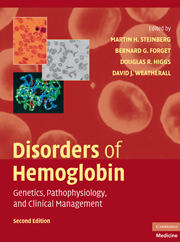Book contents
- Frontmatter
- Contents
- List of Contributors
- Foreword, by H. Franklin Bunn
- Preface
- Introduction, by David J. Weatherall
- SECTION ONE THE MOLECULAR, CELLULAR, AND GENETIC BASIS OF HEMOGLOBIN DISORDERS
- SECTION TWO PATHOPHYSIOLOGY OF HEMOGLOBIN AND ITS DISORDERS
- SECTION THREE α THALASSEMIA
- SECTION FOUR THE β THALASSEMIAS
- SECTION FIVE SICKLE CELL DISEASE
- SECTION SIX OTHER CLINICALLY IMPORTANT DISORDERS OF HEMOGLOBIN
- SECTION SEVEN SPECIAL TOPICS IN HEMOGLOBINOPATHIES
- SECTION EIGHT NEW APPROACHES TO THE TREATMENT OF HEMOGLOBINOPATHIES AND THALASSEMIA
- Index
- Plate section
Introduction, by David J. Weatherall
Published online by Cambridge University Press: 03 May 2010
- Frontmatter
- Contents
- List of Contributors
- Foreword, by H. Franklin Bunn
- Preface
- Introduction, by David J. Weatherall
- SECTION ONE THE MOLECULAR, CELLULAR, AND GENETIC BASIS OF HEMOGLOBIN DISORDERS
- SECTION TWO PATHOPHYSIOLOGY OF HEMOGLOBIN AND ITS DISORDERS
- SECTION THREE α THALASSEMIA
- SECTION FOUR THE β THALASSEMIAS
- SECTION FIVE SICKLE CELL DISEASE
- SECTION SIX OTHER CLINICALLY IMPORTANT DISORDERS OF HEMOGLOBIN
- SECTION SEVEN SPECIAL TOPICS IN HEMOGLOBINOPATHIES
- SECTION EIGHT NEW APPROACHES TO THE TREATMENT OF HEMOGLOBINOPATHIES AND THALASSEMIA
- Index
- Plate section
Summary
A few years ago, an eminent British professor of medicine, while reviewing a new edition of a well-known textbook of medicine, suggested that works of this type were becoming valueless because they were already out of date by the time they were published. His derogatory comments went further: Having taken the trouble to weigh the book, he suggested that volumes of this type would suffer the same fate as dinosaurs and become extinct by collapsing under their excessive weight. Even allowing for this bizarre and completely erroneous view of the biological fate of the dinosaurs, does this argument carry any weight beyond its metaphorical context?
Undoubtedly, there is feeling rife among medical publishers that the day of the major monograph in the biological sciences may be coming to an end. They argue that there is so much information online that the need for works of this type is becoming increasingly limited. Is this really the case? Although it is impossible to deny that the long gestation of monographs of this type may lead to the omission of the occasional “breakthrough” in a field, it seems very important that in any rapidly moving area of the biomedical sciences there is a regular and broad critical review of where it has got to and how it has been modified by recent advances. Not uncommonly in medical research and practice, today's breakthrough is tomorrow's breakdown.
Is the hemoglobin field moving rapidly? This was another question that had to be considered by the editors of this new edition.
- Type
- Chapter
- Information
- Disorders of HemoglobinGenetics, Pathophysiology, and Clinical Management, pp. xix - xxPublisher: Cambridge University PressPrint publication year: 2009



